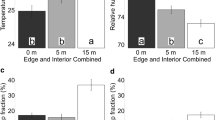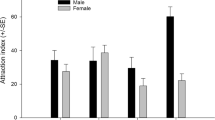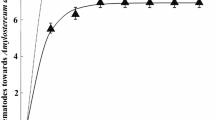Abstract
European elm bark beetles,Scolytus multistriatus (Marsh.), were strongly attracted to American elms,Ulmus americana L., baited with theS. multistriatus attractant, multilure, or killed by injection of the arboricide, cacodylic acid; a combination of the two treatments was most attractive. Comparisons of beetle catches on sticky bands affixed to the trees with samples of bark from the same trees showed that the number of beetles landing on cacodylic acid-treated trees was approximately 40 times greater than the number boring into them. Spraying the bark with the insecticide chlorpyrifos had no direct effect on attraction. No live bark beetle brood was found in trees that had been treated with cacodylic acid or chlorpyrifos, but trees that were only baited or left untreated (check) were attacked, killed, and colonized. We suggest that the contribution of the cacodylic acid trap tree technique to Dutch elm disease control will be enhanced by baiting treated trees with multilure and spraying their lower boles with 0.5% chlorpyrifos. This treatment will eliminate diseased and unwanted elms as potential breeding material and kill large numbers of elm bark beetles that might otherwise innoculate healthy elms with the Dutch elm disease fungus.
Similar content being viewed by others
References
Cuthbert, R.A., andPeacock, J.W. 1975. Attraction ofScolytus multistriatus to pheromone-baited traps at different heights.Environ. Entomol. 4:889–890.
Gardiner, L.M. 1979. Attraction ofHylurgopinus rufipes to cacodylic acid-treated trees.Entomol. Soc. Am. Bull. 25:102–104.
Gardiner, L.M., andWebb, D.P. 1980. Tests of chlorpyrifos for control of the North American elm bark beetle (Hylurgopinus rufipes Eichh.).Great Lakes Forest Res. Centre Report 0-X-311, 21pp.
Kondo, E.S., Hiratsuka, Y., andDenver, W.B.G. 1982. Procedings of the Dutch elm disease symposium and workshop. Manitoba Department Natural Resources, Winnipeg, 517 pp.
Lanier, G.N. 1981. Pheromone baited traps and trap trees in the integrated management of bark beetles in urban areas, pp. 115–131,in E.R. Mitchell (ed.). Management of Insect Pests with Semiochemicals. Plenum, New York, 514 pp.
Lanier, G.N. 1982. Behavior-modifying chemicals in Dutch elm disease control, pp. 371–394,in E.S. Kondo, Y. Hiratsuka, and W.B.G. Denyer (eds.). Proceedings of the Dutch Elm Disease Symposium and Workshop. Manitoba Department Natural Resources, Winnipeg, 517 pp.
Lanier, G.N., Silverstein, R.M., andPeacock, J.W. 1976. Attractant pheromone of the European elm bark beetle (Scolytus multistriatus): Isolation, identification, synthesis and utilization studies, pp. 149–175,in J.E. Anderson and H.K. Kaya (eds.). Perspectives in Forest Entomology. Academic Press, New York.
Lanier, G.N., Sherman, J.F., Rabaglia, R.J., andJones, A.H. 1984. Insecticides for control of bark beetles that spread Dutch elm disease.J. Arboric. 10:265–272.
O'Callaghan, D.P., Gallagher, E.M., andLanier, G.N. 1980. Field evaluation of pheromone-baited trap trees to control elm bark beetles, vectors of Dutch elm disease.Environ. Entomol. 9:181–185.
O'Callaghan, D.P., Atkins, P.M., andFairhurst, C.P. 1984. Behavioral responses of elm bark beetles to baited and unbaited elms killed by cacodylic acid.J. Chem. Ecol. 10:1623–1634.
Peacock, J.W., Cuthbert, R.A., andLanier, G.N. 1981. Deployment of traps in a barrier strategy to reduce populations of European elm bark beetles and the incidence of Dutch elm disease, pp. 155–174,in E.R. Mitchell(ed.). Management of Insect Pests with Semiochemicals. Plenum, New York, 514 pp.
Pearce, G.T., Gore, W.E., Silverstein, R.M., Peacock, J.W., Cuthbert, R.A., Lanier, G.N., andSimeone, J.B. 1975. Chemical attractants for the smaller European elm bark beetleScolytus multistriatus (Coleoptera: Scolytidae).J. Chem. Ecol. 1:115–124.
Sinclair, W.A., andCampana, R.J. 1978. Dutch elm disease, perspectives after 60 years.Search (Agr.) 8(5):1–52.
Stipes, R.J., andCampana, R.J. 1981. Compendium of Dutch Elm Disease. American Phytopathology Society, St. Paul, Minnesota, 96 pp.
Webber, J.F. 1981. A natural biological control of Dutch elm disease.Nature, 292:449–451.
Author information
Authors and Affiliations
Rights and permissions
About this article
Cite this article
Lanier, G.N., Jones, A.H. Trap trees for elm bark beetles. J Chem Ecol 11, 11–20 (1985). https://doi.org/10.1007/BF00987599
Received:
Revised:
Issue Date:
DOI: https://doi.org/10.1007/BF00987599




